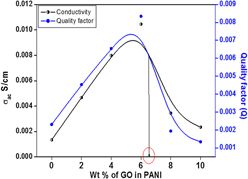Article contents
Synthesis, characterization, and dielectric studies of ortho-chloropolyaniline–graphite oxide composites
Published online by Cambridge University Press: 28 July 2015
Abstract

A facile synthesis method was adapted to prepare Ortho-chloropolyaniline/graphite oxide (OPANI/GO) composites. The properties of these composites have been discussed based on different characterizations such as scanning electron microscopy, FTIR, and dielectric studies. The important peaks of benzenoid and quinoid rings in the spectrum confirm the formation of composites. Scanning electron microscopic studies indicate that the morphology of the prepared composites was influenced by different weight ratios of GO in OPANI and the resulting micrographs of these composites exhibited flaky and folded structures. The electrical conductivity study was carried out and found that 6 wt% of GO in PANI shows high conductivity value of 20 × 10−2 S/cm. The obtained results suggest an easy approach to prepare such novel nanocomposites with excellent dielectric properties which can be used in many technological applications.
- Type
- Articles
- Information
- Copyright
- Copyright © Materials Research Society 2015
References
REFERENCES
- 8
- Cited by


